Exploring the Relationship between Urban Vibrancy and Built Environment Using Multi-Source Data: Case Study in Munich
Abstract
:1. Introduction
2. Study Area and Datasets
2.1. Study Area
2.2. Data Sources and Pre-Processing
2.2.1. Urban Vibrancy Data
- Measurement of economic vibrancy
- 2.
- Measurement of social vibrancy
- 3.
- Measurement of cultural vibrancy
- 4.
- Measurement of environmental vibrancy
- 5.
- Measurement of comprehensive vibrancy
2.2.2. Built Environment Data
3. Methodology
3.1. Bivariate Spatial Autocorrelation
3.2. Regression Analysis
3.3. Geodetector Model
4. Results
4.1. Spatial Distribution Patterns of Urban Vibrancy
4.1.1. Multi-Dimensional Urban Vibrancy Spatial Distribution
- (1)
- Economic vibrancy spatial distribution
- (2)
- Social vibrancy spatial distribution
- (3)
- Cultural vibrancy spatial distribution
- (4)
- Environmental vibrancy spatial distribution
- (5)
- Comparative analysis of spatial distribution
4.1.2. Comprehensive Vibrancy Spatial Distribution
4.1.3. Spatial Correlation in Various Types of Vibrancy
4.2. Comparison of Multiple Models Validation
4.3. Identification of Influencing Factors
4.3.1. Determining the Influence Factors of Built Environment on Urban Vibrancy
4.3.2. Exploring the Interactive Factors of Built Environment on Urban Vibrancy
5. Discussion
5.1. Theoretical and Practical Implications
5.2. Limitations and Future Research Directions
- (1)
- Expanding data sources and analytical approaches. Future research could incorporate more diverse data sources, such as POI utilization rates, social media check-in data, and street view imagery, to enrich the measurement of urban vibrancy. Additionally, the construction of the composite urban vibrancy index could be further refined by exploring alternative weighting schemes, such as principal component analysis or machine learning feature selection methods, and by conducting sensitivity analyses to test the robustness of the results.
- (2)
- Multi-regional comparisons and optimal unit selection. In the future, multi-dimensional comparative empirical research areas can be conducted, and even cities in different countries can be compared to reveal the differences and commonalities of urban vibrancy under different urban planning, cultural contexts, and policy environments. Such cross-city comparative studies are useful for understanding the general patterns and regional characteristics of urban vibrancy. Furthermore, the influence of different scales of urban research units (such as block level, community level, or urban area level) on the research results can be explored, and the scale most suitable for analyzing urban vitality can be determined, ensuring that the modifiable areal unit problem (MAUP) is scientifically feasible [44]. Determining the optimal research unit scale and division method is crucial for understanding and comparing vibrancy between different cities.Novel models and interpretability. Employing novel models and explanatory methods, such as machine learning algorithms like XGBoost, could be valuable in investigating nonlinear relationships between urban vibrancy and the built environment. However, it is crucial to prioritize the interpretability of these models to ensure that the research findings are easily understandable and actionable for urban planners and policymakers, enhancing the practical application value of these outcomes in real-world urban planning and development efforts.
- (3)
- Novel models and interpretability. Employing novel models and explanatory methods, such as machine learning algorithms like XGBoost, could be valuable in investigating nonlinear relationships between urban vibrancy and the built environment. However, it is crucial to prioritize the interpretability of these models to ensure that the research findings are easily understandable and actionable for urban planners and policymakers, enhancing the practical application value of these outcomes in real-world urban planning and development efforts.
6. Conclusions
Author Contributions
Funding
Data Availability Statement
Acknowledgments
Conflicts of Interest
References
- Wang, H.; He, Q.; Liu, X.; Zhuang, Y.; Hong, S. Global Urbanization Research from 1991 to 2009: A Systematic Research Review. Landsc. Urban Plan. 2012, 104, 299–309. [Google Scholar] [CrossRef]
- Ameen, R.F.M.; Mourshed, M. Urban Environmental Challenges in Developing Countries—A Stakeholder Perspective. Habitat Int. 2017, 64, 1–10. [Google Scholar] [CrossRef]
- Seeliger, L.; Turok, I. Towards Sustainable Cities: Extending Resilience with Insights from Vulnerability and Transition Theory. Sustainability 2013, 5, 2108–2128. [Google Scholar] [CrossRef]
- Huang, B.; Zhou, Y.; Li, Z.; Song, Y.; Cai, J.; Tu, W. Evaluating and Characterizing Urban Vibrancy Using Spatial Big Data: Shanghai as a Case Study. Environ. Plan. B Urban Anal. City Sci. 2020, 47, 1543–1559. [Google Scholar] [CrossRef]
- Jia, C.; Liu, Y.; Du, Y.; Huang, J.; Fei, T. Evaluation of Urban Vibrancy and Its Relationship with the Economic Landscape: A Case Study of Beijing. ISPRS Int. Geo-Inf. 2021, 10, 72. [Google Scholar] [CrossRef]
- Jacobs, J. The Death and Life of Great American Cities; Reissue edition; Vintage: New York, NY, USA, 1992; ISBN 978-0-679-74195-4. [Google Scholar]
- Landry, C. The Creative City: A Toolkit for Urban Innovators, 1st ed.; Earthscan Publications Ltd.: London, UK, 2000; ISBN 978-1-85383-613-8. [Google Scholar]
- Magurran, A. Ecological Diversity and Its Measurement, 1st ed.; Croom Helm: London, UK, 1988; ISBN 978-0-7099-3539-1. [Google Scholar]
- Wang, S.; Wang, J.; Li, W.; Fan, J.; Liu, M. Revealing the Influence Mechanism of Urban Built Environment on Online Car-Hailing Travel Considering Orientation Entropy of Street Network. Discret. Dyn. Nat. Soc. 2022, 2022, 3888800. [Google Scholar] [CrossRef]
- Kang, C.; Fan, D.; Jiao, H. Validating Activity, Time, and Space Diversity as Essential Components of Urban Vitality. Environ. Plan. B-Urban Anal. City Sci. 2021, 48, 1180–1197. [Google Scholar] [CrossRef]
- Wu, J.; Wang, B.; Wang, R.; Ta, N.; Chai, Y. Active Travel and the Built Environment: A Theoretical Model and Multidimensional Evidence. Transport. Res. Part D-Transport. Environ. 2021, 100, 103029. [Google Scholar] [CrossRef]
- Gao, C.; Lai, X.; Li, S.; Cui, Z.; Long, Z. Bibliometric Insights into the Implications of Urban Built Environment on Travel Behavior. ISPRS Int. J. Geo-Inf. 2023, 12, 453. [Google Scholar] [CrossRef]
- Gómez-Varo, I.; Delclòs-Alió, X.; Miralles-Guasch, C. Jane Jacobs Reloaded: A Contemporary Operationalization of Urban Vitality in a District in Barcelona. Cities 2022, 123, 103565. [Google Scholar] [CrossRef]
- Cao, X.; Mokhtarian, P.L.; Handy, S.L. Do Changes in Neighborhood Characteristics Lead to Changes in Travel Behavior? A Structural Equations Modeling Approach. Transportation 2007, 34, 535–556. [Google Scholar] [CrossRef]
- Cervero, R.; Kockelman, K. Travel Demand and the 3Ds: Density, Diversity, and Design. Transp. Res. Part D Transp. Environ. 1997, 2, 199–219. [Google Scholar] [CrossRef]
- Ewing, R.; Cervero, R. Travel and the Built Environment: A Meta-Analysis. J. Am. Plan. Assoc. 2010, 76, 265–294. [Google Scholar] [CrossRef]
- Chen, L.; Lu, Y.; Ye, Y.; Xiao, Y.; Yang, L. Examining the Association between the Built Environment and Pedestrian Volume Using Street View Images. Cities 2022, 127, 103734. [Google Scholar] [CrossRef]
- Sung, H.; Lee, S. Residential Built Environment and Walking Activity: Empirical Evidence of Jane Jacobs’ Urban Vitality. Transp. Res. Part D Transp. Environ. 2015, 41, 318–329. [Google Scholar] [CrossRef]
- Jiang, H.; Dong, L.; Qiu, B. How Are Macro-Scale and Micro-Scale Built Environments Associated with Running Activity? The Application of Strava Data and Deep Learning in Inner London. ISPRS Int. J. Geo-Inf. 2022, 11, 504. [Google Scholar] [CrossRef]
- Ma, D.; Osaragi, T.; Oki, T.; Jiang, B. Exploring the Heterogeneity of Human Urban Movements Using Geo-Tagged Tweets. Int. J. Geogr. Inf. Sci. 2020, 34, 2475–2496. [Google Scholar] [CrossRef]
- Lin, C.; Liu, G.; Müller, D.B. Characterizing the Role of Built Environment Stocks in Human Development and Emission Growth. Resour. Conserv. Recycl. 2017, 123, 67–72. [Google Scholar] [CrossRef]
- Yang, X.; Zhao, Z.; Shi, C.; Luo, L.; Tu, W. The Dynamic Heterogeneous Relationship between Urban Population Distribution and Built Environment in Xi’an, China: A Case Study. Remote Sens. 2023, 15, 2257. [Google Scholar] [CrossRef]
- Cheng, L.; Shi, K.; De Vos, J.; Cao, M.; Witlox, F. Examining the Spatially Heterogeneous Effects of the Built Environment on Walking among Older Adults. Transp. Policy 2021, 100, 21–30. [Google Scholar] [CrossRef]
- Chen, L.; Zhao, L.; Xiao, Y.; Lu, Y. Investigating the Spatiotemporal Pattern between the Built Environment and Urban Vibrancy Using Big Data in Shenzhen, China. Comput. Environ. Urban Syst. 2022, 95, 101827. [Google Scholar] [CrossRef]
- Li, J.; Lo, K.; Zhang, P.; Guo, M. Relationship between Built Environment, Socio-Economic Factors and Carbon Emissions from Shopping Trip in Shenyang City, China. Chin. Geogr. Sci. 2017, 27, 722–734. [Google Scholar] [CrossRef]
- Shi, Y.; Zheng, J.; Pei, X. Measurement Method and Influencing Mechanism of Urban Subdistrict Vitality in Shanghai Based on Multisource Data. Remote Sens. 2023, 15, 932. [Google Scholar] [CrossRef]
- Mouratidis, K. Urban Planning and Quality of Life: A Review of Pathways Linking the Built Environment to Subjective Well-Being. Cities 2021, 115, 103229. [Google Scholar] [CrossRef]
- Alavipanah, S.; Wegmann, M.; Qureshi, S.; Weng, Q.; Koellner, T. The Role of Vegetation in Mitigating Urban Land Surface Temperatures: A Case Study of Munich, Germany during the Warm Season. Sustainability 2015, 7, 4689–4706. [Google Scholar] [CrossRef]
- Montgomery, J. Making a City: Urbanity, Vitality and Urban Design. J. Urban Des. 1998, 3, 93–116. [Google Scholar] [CrossRef]
- Sung, H.; Lee, S.; Cheon, S. Operationalizing Jane Jacobs’s Urban Design Theory: Empirical Verification from the Great City of Seoul, Korea. J. Plan. Educ. Res. 2015, 35, 117–130. [Google Scholar] [CrossRef]
- Jones, C.; Newsome, D. Perth (Australia) as One of the World’s Most Liveable Cities: A Perspective on Society, Sustainability and Environment. Int. J. Tour. Cities 2015, 1, 18–35. [Google Scholar] [CrossRef]
- Bennett, M.M.; Smith, L.C. Advances in Using Multitemporal Night-Time Lights Satellite Imagery to Detect, Estimate, and Monitor Socioeconomic Dynamics. Remote Sens. Environ. 2017, 192, 176–197. [Google Scholar] [CrossRef]
- Wu, C.; Ye, X.; Ren, F.; Wan, Y.; Ning, P.; Du, Q. Spatial and Social Media Data Analytics of Housing Prices in Shenzhen, China. PLoS ONE 2016, 11, e0164553. [Google Scholar] [CrossRef]
- Yue, Y.; Zhuang, Y.; Yeh, A.G.; Xie, J.Y.; Ma, C.L.; Li, Q.Q. Measurements of POI-Based Mixed Use and Their Relationships with Neighbourhood Vibrancy. Int. J. Geogr. Inf. Sci. 2017, 31, 658–675. [Google Scholar] [CrossRef]
- Kang, C.-D. Effects of Spatial Access to Neighborhood Land-Use Density on Housing Prices: Evidence from a Multilevel Hedonic Analysis in Seoul, South Korea. Environ. Plan. B-Urban Anal. City Sci. 2019, 46, 603–625. [Google Scholar] [CrossRef]
- Zhou, Y.; He, X.; Zikirya, B. Boba Shop, Coffee Shop, and Urban Vitality and Development—A Spatial Association and Temporal Analysis of Major Cities in China from the Standpoint of Nighttime Light. Remote Sens. 2023, 15, 903. [Google Scholar] [CrossRef]
- Huang, H.; Yao, X.A.; Krisp, J.M.; Jiang, B. Analytics of Location-Based Big Data for Smart Cities: Opportunities, Challenges, and Future Directions. Comput. Environ. Urban Syst. 2021, 90, 101712. [Google Scholar] [CrossRef]
- Chen, Y.; Yu, B.; Shu, B.; Yang, L.; Wang, R. Exploring the Spatiotemporal Patterns and Correlates of Urban Vitality: Temporal and Spatial Heterogeneity. Sustain. Cities Soc. 2023, 91, 104440. [Google Scholar] [CrossRef]
- Anselin, L. Spatial Econometrics: Methods and Models; Springer Science & Business Media: Berlin/Heidelberg, Germany, 1988; ISBN 978-90-247-3735-2. [Google Scholar]
- Anselin, L. Local Indicators of Spatial Association—LISA. Geogr. Anal. 1995, 27, 93–115. [Google Scholar] [CrossRef]
- Wang, J.; Li, X.; Christakos, G.; Liao, Y.; Zhang, T.; Gu, X.; Zheng, X. Geographical Detectors-Based Health Risk Assessment and Its Application in the Neural Tube Defects Study of the Heshun Region, China. Int. J. Geogr. Inf. Sci. 2010, 24, 107–127. [Google Scholar] [CrossRef]
- Wang, J.-F.; Zhang, T.-L.; Fu, B.-J. A Measure of Spatial Stratified Heterogeneity. Ecol. Indic. 2016, 67, 250–256. [Google Scholar] [CrossRef]
- Meng, Y.; Xing, H. Exploring the Relationship between Landscape Characteristics and Urban Vibrancy: A Case Study Using Morphology and Review Data. Cities 2019, 95, 102389. [Google Scholar] [CrossRef]
- Gao, F.; Li, S.; Tan, Z.; Wu, Z.; Zhang, X.; Huang, G.; Huang, Z. Understanding the Modifiable Areal Unit Problem in Dockless Bike Sharing Usage and Exploring the Interactive Effects of Built Environment Factors. Int. J. Geogr. Inf. Sci. 2021, 35, 1905–1925. [Google Scholar] [CrossRef]
- Wolff, M.; Wiechmann, T. Urban Growth and Decline: Europe’s Shrinking Cities in a Comparative Perspective 1990–2010. Eur. Urban Reg. Stud. 2018, 25, 122–139. [Google Scholar] [CrossRef]
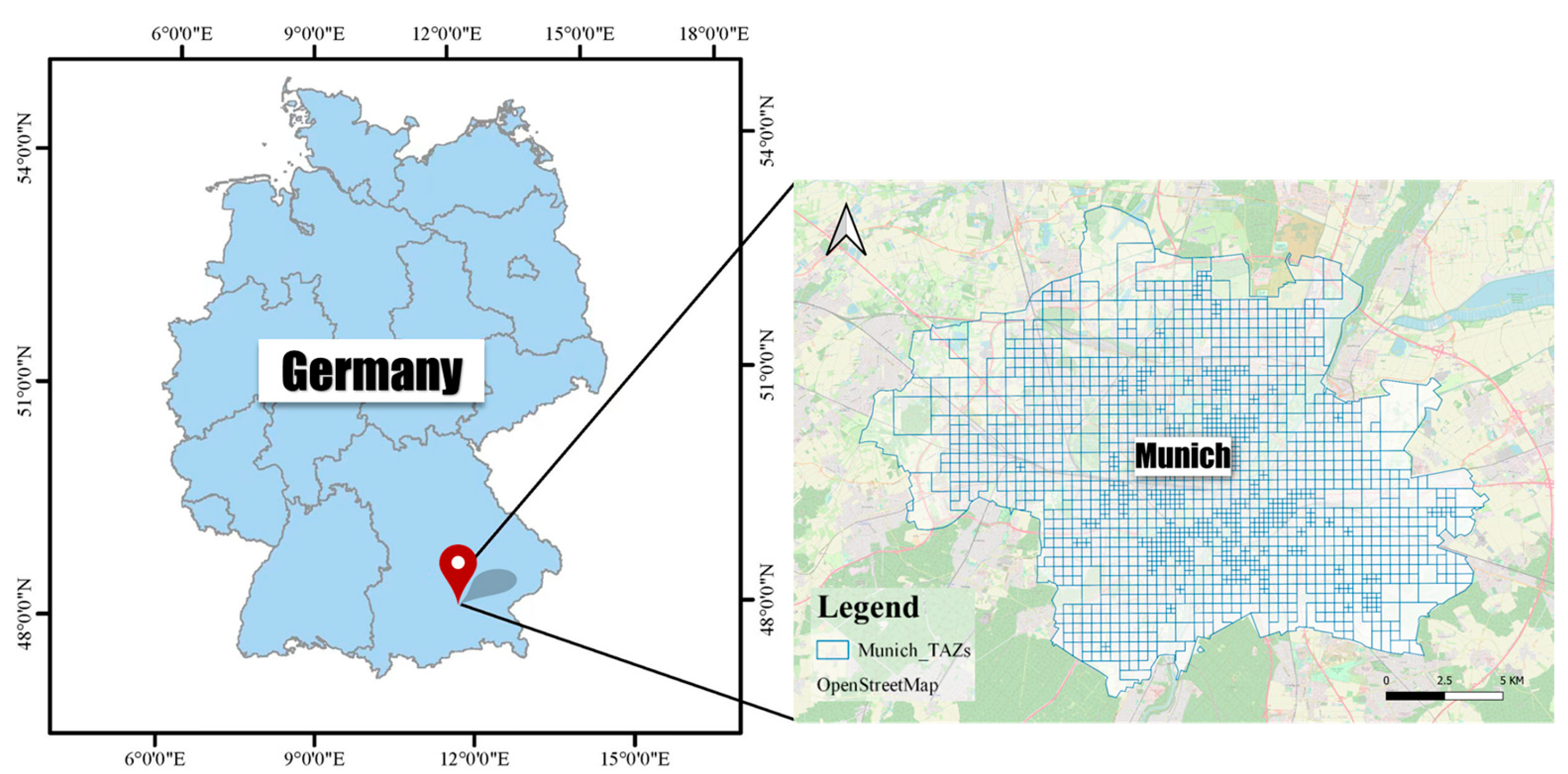
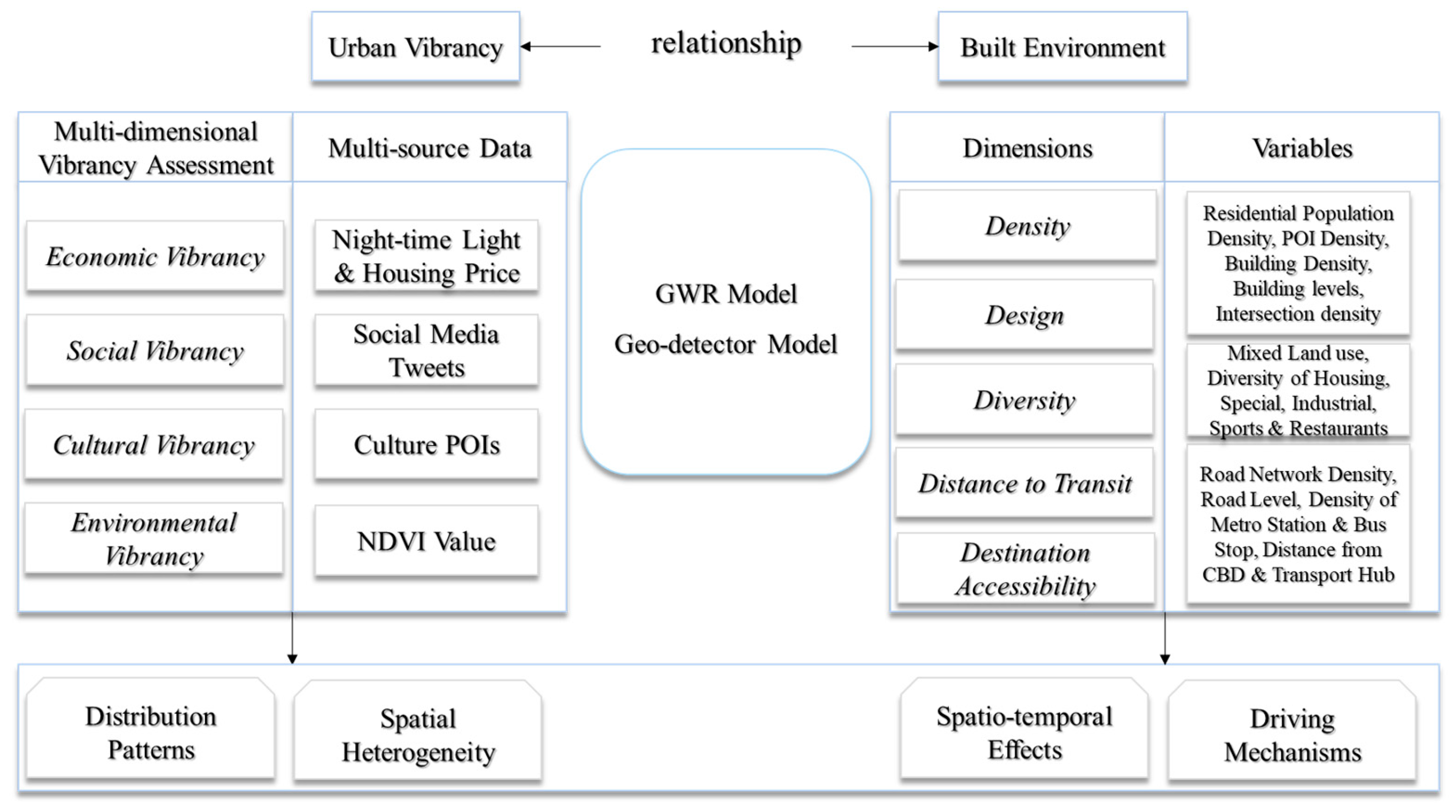


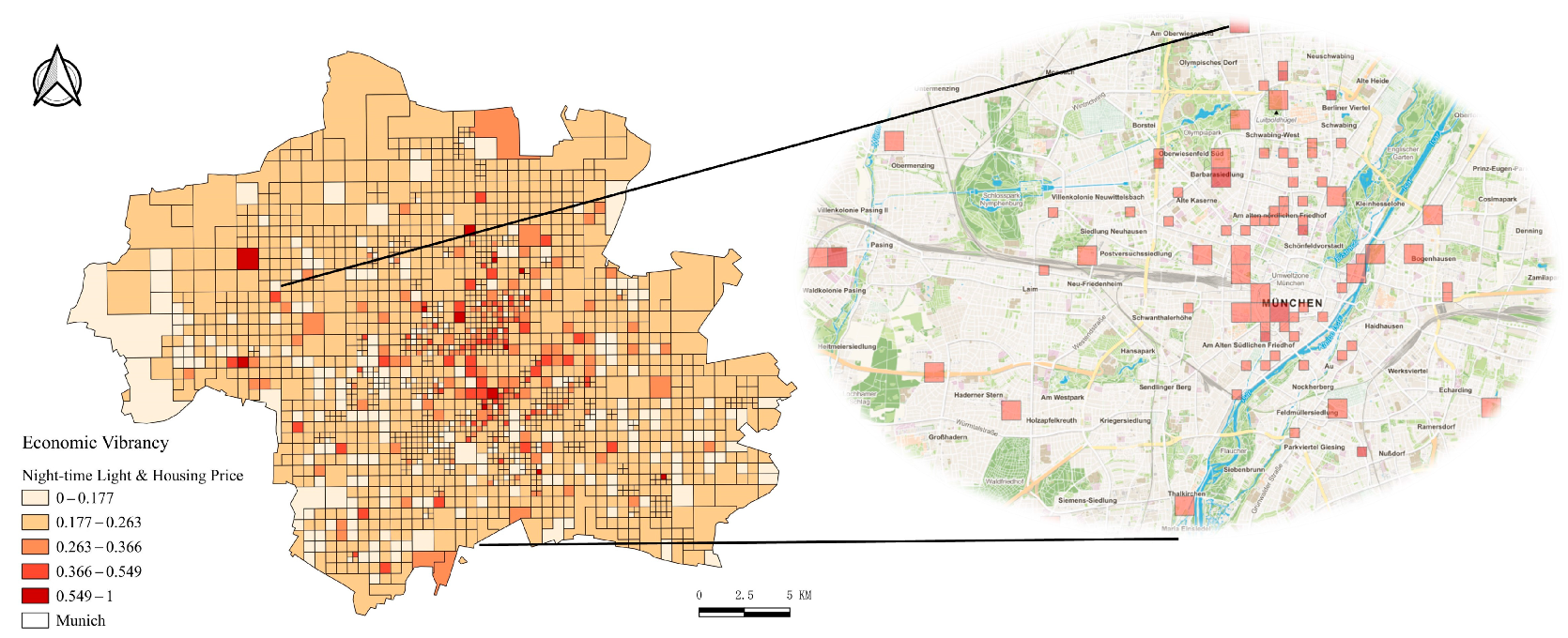
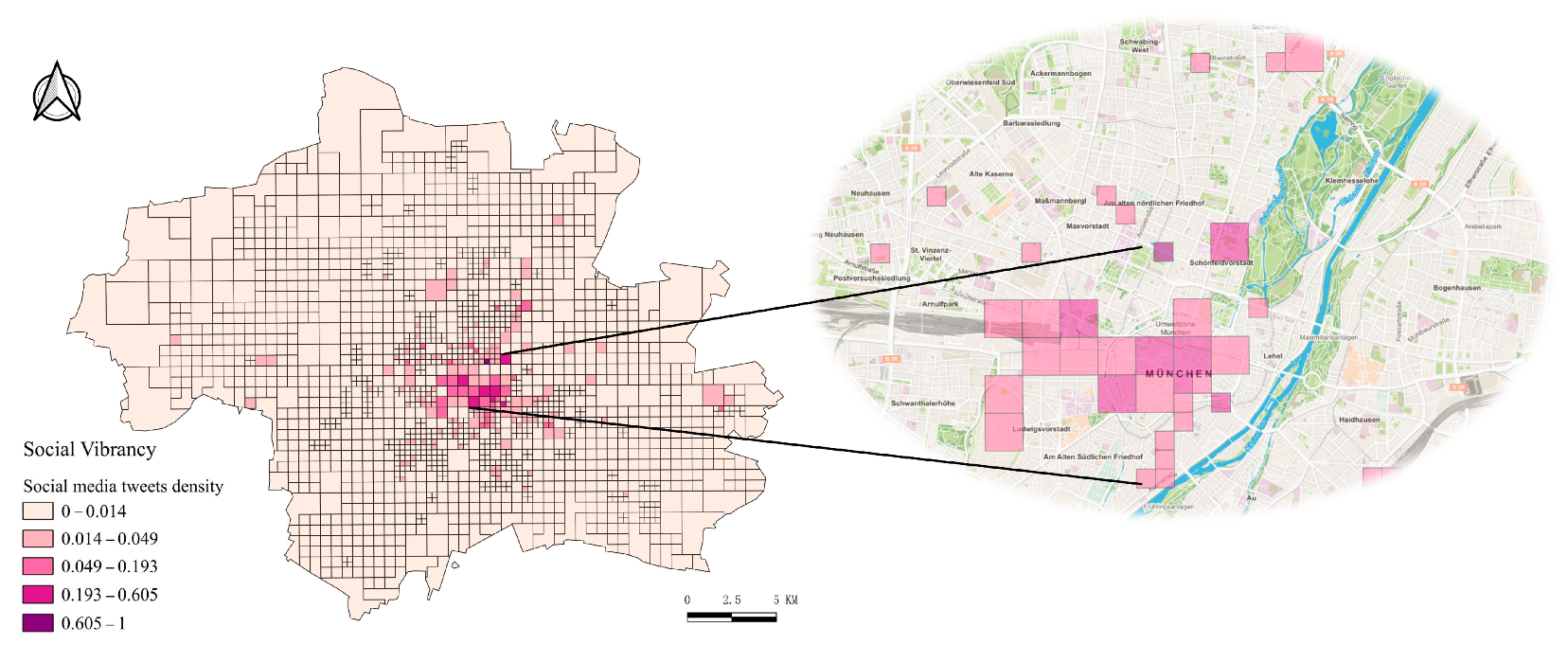
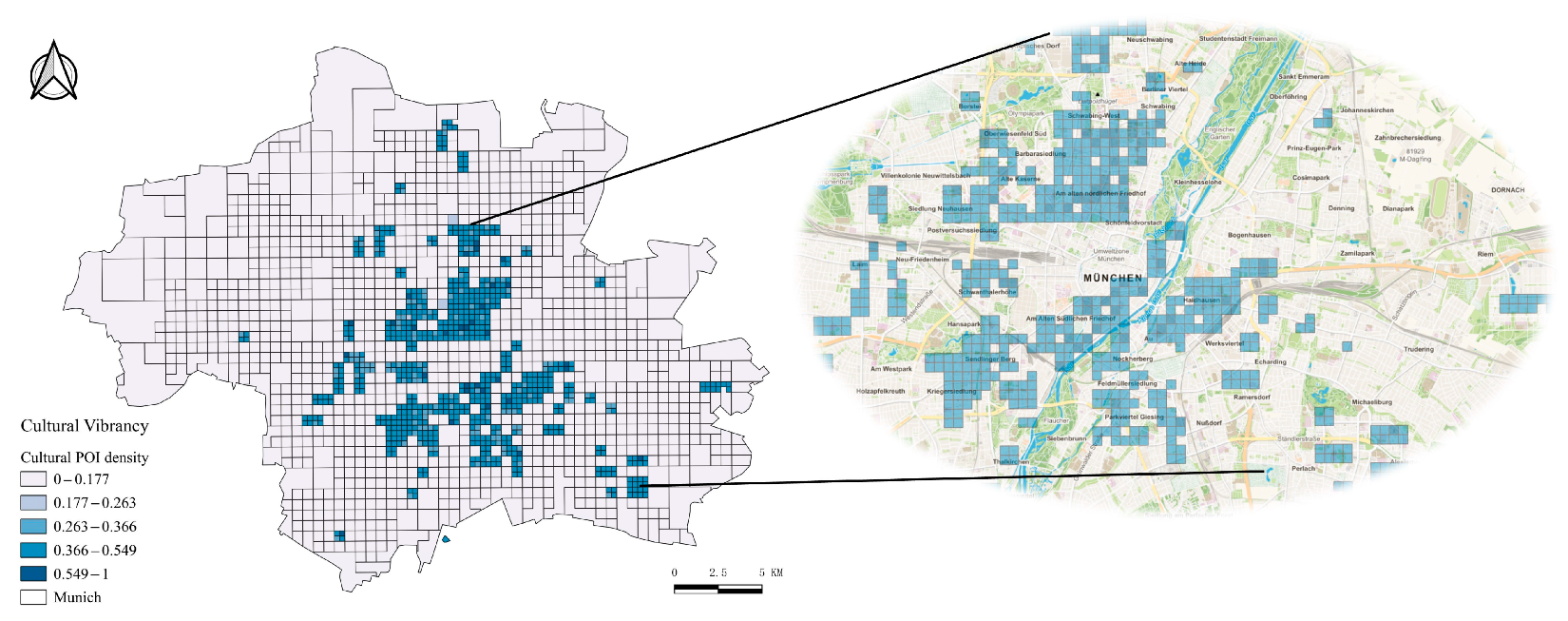
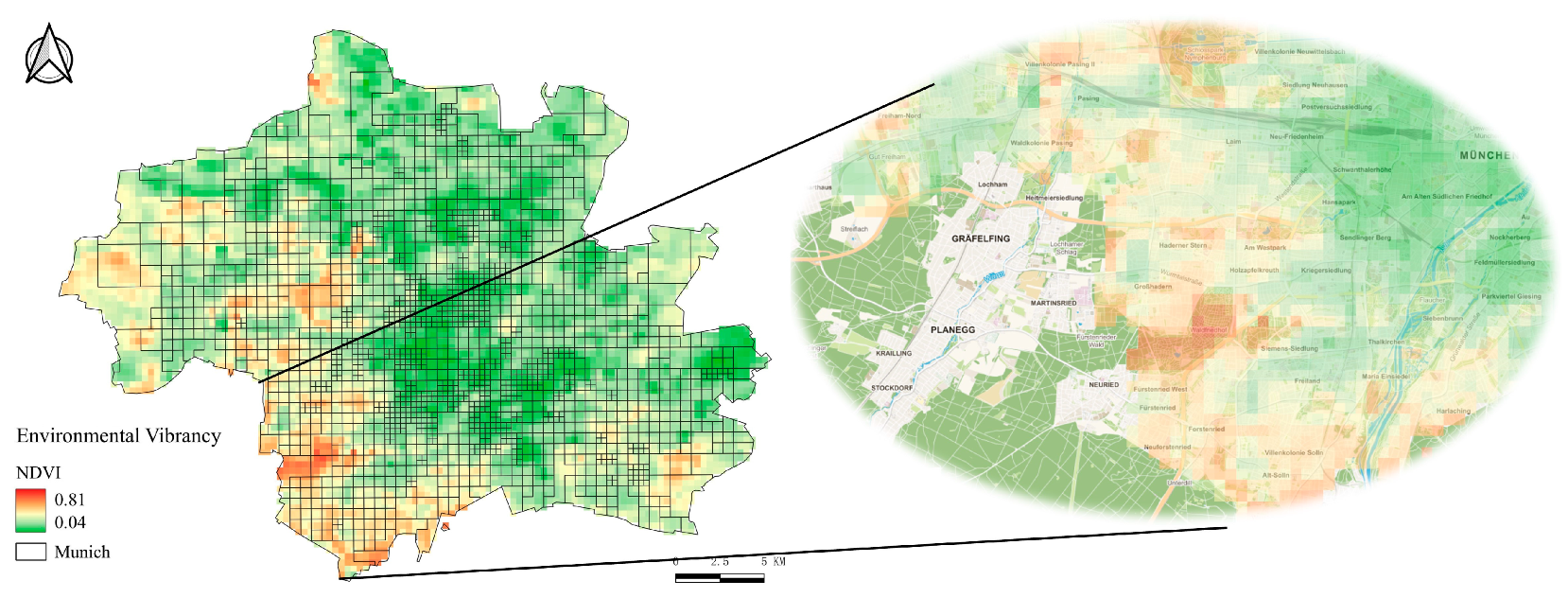
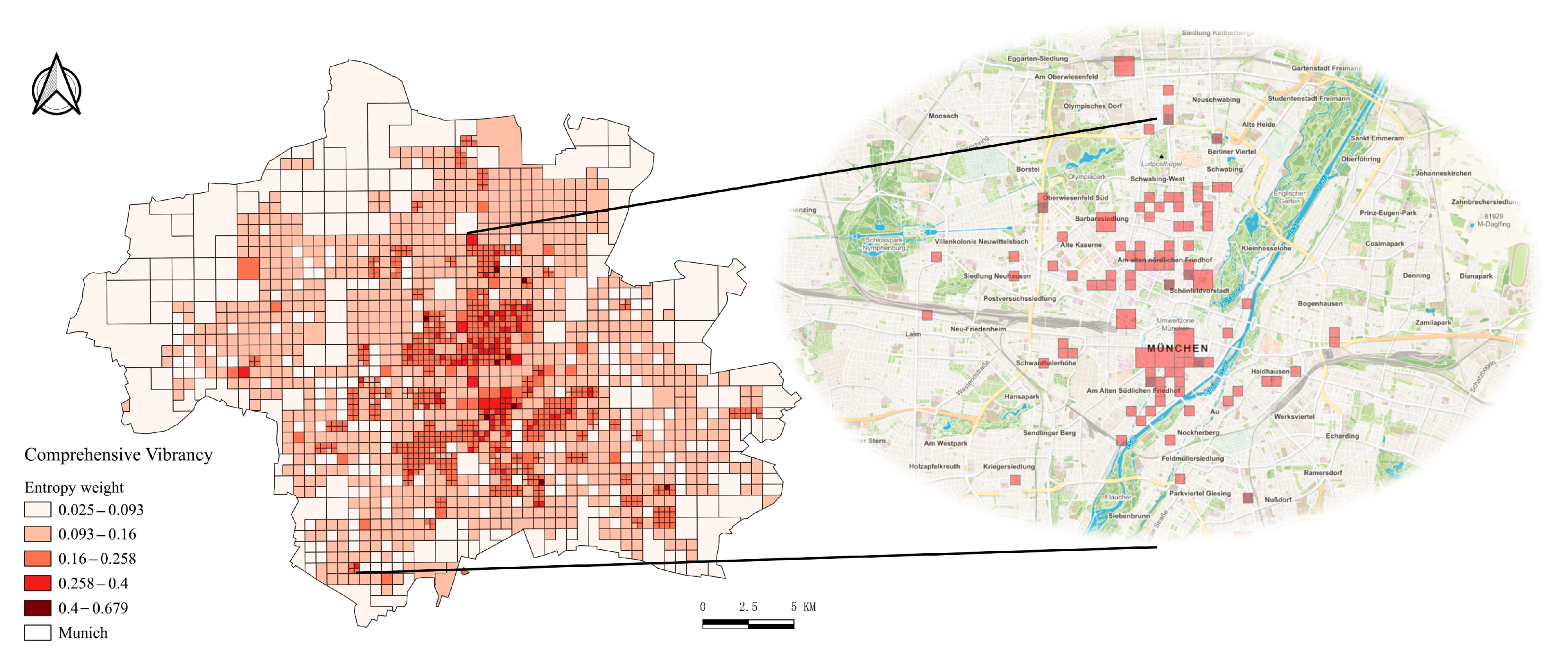
| Data | Source | Numbers and Type | Time Period | Spatial Resolution |
|---|---|---|---|---|
| Night-time light | Annual composite imagery of night-time light from https://ngdc.noaa.gov, accessed on 22 June 2023 | Raster tiff | 2019 | 500 m |
| Housing price | Munich average house price from https://www.opengov-muenchen.de, accessed on 22 June 2023 | 974,393 vector polygons | 2018 | / |
| Social media tweets | Geotagged tweets from https://developer.twitter.com/en/docs/twitter-api, accessed on 22 June 2023 | 1,176,798 vector points | 2018–2019 | / |
| Cultural POIs | Locations of cultural venues from https://www.openstreetmap.org/, accessed on 22 June 2023 | 163,505 vector points | 2019 | / |
| NDVI value | Sentinel-2 satellite imagery from https://sentinels.copernicus.eu/web/sentinel/sentinel-2, accessed on 22 June 2023 | Raster tiff | June 2020 | 10 m |
| No. | Factors | Abb. | Min | Mean | Max | Std. | VIF |
|---|---|---|---|---|---|---|---|
| 1 | Night-time light | EI-Y1 | 0 | 2078 | 7,315,148 | 298,403.9 | / |
| Housing price | 9.3 | 16.80 | 42.70 | 3.70 | / | ||
| 2 | Social media tweet density (million·km−2) | SI-Y2 | 0 | 9633.9 | 1312.1 | 47,983.9 | / |
| 3 | Cultural POI density (million·km−2) | CI-Y3 | 0 | 53.70 | 1275 | 100.50 | / |
| 4 | NDVI | VI-Y4 | 0 | 0.41 | 0.81 | 0.23 | / |
| 5 | Comprehensive vibrancy | UI-Y5 | 0.025 | 0.349 | 0.679 | 0.190 | / |
| 6 | Population density (million·km−2) | RPD-X1 | 0 | 9031.40 | 34,300 | 7958 | 1.254 |
| 7 | POI density (million·km−2) | PD-X2 | 0 | 2204.70 | 30,750 | 2981.10 | 1.635 |
| 8 | Building density (million·km−2) | BD-X3 | 0 | 270 | 3754 | 285.6 | 2.187 |
| 9 | Intersection density | ID-X4 | 0 | 3194.90 | 72,500 | 5896.90 | 1.981 |
| 10 | Mixed land use | MUD-X5 | 0 | 0.11 | 0.93 | 0.14 | 1.473 |
| 11 | Road network density | RND-X6 | 55,786.6 | 36,834.6 | 93,112.8 | 139,778 | 1.842 |
| 12 | Metro station density | MSD-X7 | 0 | 8.60 | 500 | 40.40 | 2.197 |
| 13 | Bus stop density | BS-X8 | 0 | 104.40 | 2000 | 175.30 | 2.214 |
| 14 | Distance to the CBD (km) | DCBD-X9 | 0.27 | 6.30 | 15.90 | 2.90 | 1.127 |
| 15 | Distance to transit hubs (km) | DTH-X10 | 0.26 | 6.30 | 15.00 | 2.90 | 1.564 |
| Criterion | Interaction Types |
|---|---|
| q(X1∩X2) < Min(q(X1), q(X2)) | Nonlinear, weakens |
| Min(q(X1), q(X2)) < q(X1∩X2) < Max(q(X1), q(X2)) | Univariate, weakens |
| q(X1∩X2) > Max(q(X1), q(X2)) | Bivariate, enhances |
| q(X1∩X2) = q(X1) + q(X2) | Independent |
| q(X1∩X2) > q(X1) + q(X2) | Nonlinear, enhances |
| Factors | Moran’s I | |
|---|---|---|
| Comprehensive vibrancy (Y5) | Economic vibrancy (Y1) | 0.714 |
| Comprehensive vibrancy (Y5) | Social vibrancy (Y2) | 0.791 |
| Comprehensive vibrancy (Y5) | Cultural vibrancy (Y3) | 0.431 |
| Comprehensive vibrancy (Y5) | Environmental vibrancy (Y4) | −0.294 |
| Economic vibrancy (Y1) | Social vibrancy (Y2) | 0.642 |
| Economic vibrancy (Y1) | Cultural vibrancy (Y3) | 0.352 |
| Economic vibrancy (Y1) | Environmental vibrancy (Y4) | −0.131 |
| Social vibrancy (Y2) | Cultural vibrancy (Y3) | 0.639 |
| Social vibrancy (Y2) | Environmental vibrancy (Y4) | 0.218 |
| Cultural vibrancy (Y3) | Environmental vibrancy (Y4) | 0.167 |
| Test Type | Standardized Value of Test Statistic | Test Statistic | p-Value |
|---|---|---|---|
| Moran’s I—error | 0.0923 | 3.123 | 0.00179 |
| Lagrange multiplier—lag | 1 | 11.1597 | 0.00084 |
| Robust LM—lag | 1 | 8.0495 | 0.00455 |
| Lagrange multiplier—error | 1 | 5.7283 | 0.01669 |
| Robust LM—error | 1 | 2.6181 | 0.10565 |
| Lagrange multiplier—SARMA | 2 | 13.7778 | 0.00102 |
| Global Models | Adj. R2 | RSS | AICc | Local Models | Adj. R2 | RSS | AICc |
|---|---|---|---|---|---|---|---|
| MLR(Y1) | 0.288 | 71.691 | −127.382 | GWR(Y1) | 0.505 | 99.945 | 501.959 |
| SLM(Y1) | 0.438 | 86.981 | −155.962 | ||||
| SEM(Y1) | 0.452 | 88.490 | −160.98 | ||||
| MLR(Y2) | 0.370 | 98.534 | −181.068 | GWR(Y2) | 0.592 | 82.506 | 473.456 |
| SLM(Y2) | 0.431 | 99.471 | −180.941 | ||||
| SEM(Y2) | 0.447 | 101.039 | −186.078 | ||||
| MLR(Y3) | 0.310 | 94.805 | −173.611 | GWR(Y3) | 0.520 | 96.899 | 499.738 |
| SLM(Y3) | 0.380 | 100.03 | −182.061 | ||||
| SEM(Y3) | 0.273 | 83.38 | −150.76 | ||||
| MLR(Y4) | 0.314 | 89.783 | −163.566 | GWR(Y4) | 0.574 | 86.082 | 475.654 |
| SLM(Y4) | 0.382 | 94.885 | −171.770 | ||||
| SEM(Y4) | 0.368 | 92.923 | −169.847 | ||||
| MLR(Y5) | 0.614 | 77.958 | 455.164 | GWR(Y5) | 0.601 | 80.694 | 476.205 |
| SLM(Y5) | 0.603 | 80.123 | 476.595 | ||||
| SEM(Y5) | 0.640 | 72.698 | 455.564 |
| Detection Factors | Y1 | Y2 | Y3 | Y4 | Y5 |
|---|---|---|---|---|---|
| RPD-X1 | 0.101 ** | 0.128 ** | 0.194 ** | 0.048 ** | 0.131 ** |
| PD-X2 | 0.414 ** | 0.164 ** | 0.157 ** | 0.106 ** | 0.593 ** |
| BD-X3 | 0.393 ** | 0.116 ** | 0.290 ** | 0.169 * | 0.443 ** |
| ID-X4 | 0.212 ** | 0.196 * | 0.112 ** | 0.143 * | 0.199 ** |
| MUD-X5 | 0.049 ** | 0.161 ** | 0.124 ** | 0.121 ** | 0.057 ** |
| RND-X6 | 0.120 ** | 0.139 ** | 0.127 ** | 0.091 * | 0.141 ** |
| MSD-X7 | 0.043 * | 0.131 ** | 0.264 ** | 0.109 * | 0.069 * |
| BS-X8 | 0.249 ** | 0.167 * | 0.101 ** | 0.175 ** | 0.187 ** |
| DCBD-X9 | 0.101 ** | 0.169 ** | 0.171 ** | 0.198 * | 0.109 ** |
| DTH-X10 | 0.099 ** | 0.127 ** | 0.306 ** | 0.189 * | 0.149 ** |
| A∩B | Y1 | Y2 | Y3 | Y4 | Y5 | A∩B | Y1 | Y2 | Y3 | Y4 | Y5 |
|---|---|---|---|---|---|---|---|---|---|---|---|
| X1∩X2 | 0.351 | 0.201 | 0.171 | 0.094 | 0.511 | X3∩X10 | 0.354 | 0.115 | 0.251 | 0.151 | 0.401 |
| X1∩X3 | 0.399 * | 0.186 | 0.221 * | 0.152 | 0.434 | X4∩X5 | 0.201 | 0.11 | 0.151 * | 0.123 | 0.220 * |
| X1∩X4 | 0.211 | 0.206 | 0.131 | 0.141 | 0.199 | X4∩X6 | 0.221 * | 0.192 * | 0.184 * | 0.146 * | 0.241 * |
| X1∩X5 | 0.129 * | 0.154 | 0.145 | 0.120 | 0.131 | X4∩X7 | 0.232 * | 0.221 * | 0.261 * | 0.169 * | 0.254 * |
| X1∩X6 | 0.154 * | 0.173 | 0.164 | 0.099 | 0.186 * | X4∩X8 | 0.264 * | 0.239 * | 0.191 * | 0.171 * | 0.271 * |
| X1∩X7 | 0.121 * | 0.164 | 0.21 * | 0.108 | 0.141 | X4∩X9 | 0.191 | 0.201 * | 0.224 * | 0.152 * | 0.197 |
| X1∩X8 | 0.202 * | 0.182 | 0.152 | 0.171 | 0.181 * | X4∩X10 | 0.194 | 0.216 * | 0.301 | 0.133 | 0.199 |
| X1∩X9 | 0.132 | 0.186 | 0.174 | 0.192 | 0.156 | X4∩X6 | 0.119 | 0.151 | 0.117 | 0.111 | 0.127 |
| X1∩X10 | 0.131 | 0.168 | 0.251 | 0.142 | 0.147 | X5∩X7 | 0.131 * | 0.161 | 0.241 * | 0.122 * | 0.171 * |
| X2∩X3 | 0.401 * | 0.171 | 0.22 | 0.162 * | 0.516 | X5∩X8 | 0.161 * | 0.171 * | 0.154 * | 0.131 * | 0.179 * |
| X2∩X4 | 0.311 | 0.224 * | 0.134 | 0.151 | 0.309 | X5∩X9 | 0.112 | 0.161 | 0.171 | 0.114 | 0.15 |
| X2∩X5 | 0.303 | 0.141 | 0.156 | 0.125 | 0.297 | X5∩X10 | 0.141 | 0.159 | 0.289 | 0.148 | 0.154 * |
| X2∩X6 | 0.334 | 0.221 * | 0.167 | 0.095 | 0.364 | X6∩X7 | 0.161 * | 0.139 * | 0.215 * | 0.112 * | 0.211 * |
| X2∩X7 | 0.326 | 0.111 | 0.211 | 0.11 | 0.336 | X6∩X8 | 0.196 * | 0.201 * | 0.171 * | 0.144 | 0.221 * |
| X2∩X8 | 0.368 | 0.214 * | 0.157 | 0.182 | 0.397 | X6∩X9 | 0.153 * | 0.184 * | 0.191 * | 0.161 * | 0.204 * |
| X2∩X9 | 0.354 | 0.134 | 0.176 | 0.201 | 0.356 | X6∩X10 | 0.141 | 0.171 * | 0.294 | 0.177 * | 0.149 |
| X2∩X10 | 0.356 | 0.19 * | 0.234 | 0.196 | 0.374 | X7∩X8 | 0.211 | 0.147 * | 0.273 * | 0.197 * | 0.265 * |
| X3∩X4 | 0.302 | 0.201 | 0.201 | 0.156 | 0.322 | X7∩X9 | 0.171 * | 0.149 | 0.214 | 0.144 | 0.244 * |
| X3∩X5 | 0.297 | 0.146 | 0.214 * | 0.171 * | 0.306 | X7∩X10 | 0.129 | 0.209 * | 0.317 * | 0.167 * | 0.106 |
| X3∩X6 | 0.322 | 0.131 | 0.210 | 0.146 | 0.374 | X8∩X9 | 0.071 | 0.241 * | 0.161 | 0.172 | 0.104 |
| X3∩X7 | 0.322 | 0.191 * | 0.251 * | 0.157 * | 0.347 | X8∩X10 | 0.141 | 0.234 * | 0.331 * | 0.221 * | 0.159 |
| X3∩X8 | 0.356 | 0.167 * | 0.201 | 0.221 * | 0.403 | X9∩X10 | 0.131 | 0.112 | 0.302 | 0.141 | 0.148 |
| X3∩X9 | 0.346 | 0.114 | 0.197 | 0.149 | 0.361 |
Disclaimer/Publisher’s Note: The statements, opinions and data contained in all publications are solely those of the individual author(s) and contributor(s) and not of MDPI and/or the editor(s). MDPI and/or the editor(s) disclaim responsibility for any injury to people or property resulting from any ideas, methods, instructions or products referred to in the content. |
© 2024 by the authors. Licensee MDPI, Basel, Switzerland. This article is an open access article distributed under the terms and conditions of the Creative Commons Attribution (CC BY) license (https://creativecommons.org/licenses/by/4.0/).
Share and Cite
Gao, C.; Li, S.; Sun, M.; Zhao, X.; Liu, D. Exploring the Relationship between Urban Vibrancy and Built Environment Using Multi-Source Data: Case Study in Munich. Remote Sens. 2024, 16, 1107. https://doi.org/10.3390/rs16061107
Gao C, Li S, Sun M, Zhao X, Liu D. Exploring the Relationship between Urban Vibrancy and Built Environment Using Multi-Source Data: Case Study in Munich. Remote Sensing. 2024; 16(6):1107. https://doi.org/10.3390/rs16061107
Chicago/Turabian StyleGao, Chao, Shasha Li, Maopeng Sun, Xiyang Zhao, and Dewen Liu. 2024. "Exploring the Relationship between Urban Vibrancy and Built Environment Using Multi-Source Data: Case Study in Munich" Remote Sensing 16, no. 6: 1107. https://doi.org/10.3390/rs16061107







